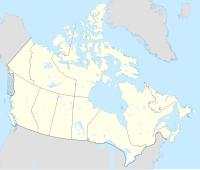Creemore
This articleneeds additional citations forverification.(December 2020) |
Creemore | |
|---|---|
 | |
| Coordinates:44°19′N80°06′W/ 44.317°N 80.100°W | |
| Country | Canada |
| Province | Ontario |
| County | Simcoe |
| Municipality | Clearview |
| Government | |
| • Mayor | Doug Measures |
| • MP | Terry Dowdall(C) |
| • MPP | Brian Saunderson(PC) |
| Area | |
| • Total | 1.59 km2(0.61 sq mi) |
| Population (2021)[1] | |
| • Total | 1,194 |
| • Density | 750.8/km2(1,945/sq mi) |
| Time zone | UTC−05:00(EST) |
| • Summer (DST) | UTC−04:00(EDT) |
| Postal code | L0M |
Creemore(fromIrishCroí Mór'big heart') is a former village, now part ofClearview Township,located inSimcoe County,Ontario,Canada. It lies approximately 130 km (81 mi) north ofToronto,40 minutes west ofBarrie,and 20 minutes south ofCollingwoodandGeorgian Bay.It sits on the eastern boundary of theNiagara Escarpment.[2]
Creemore purportedly has North America's smallest jail.CoboconkandTweedmake similar claims of their jails.
History
[edit]The settlement of Creemore began in 1842 and by the turn of the century it was a thriving village of about 800 people with a vibrant business community.
In 1993, the amalgamation of Sunnidale, Nottawasaga, Village of Creemore and Town of Stayner took place and it became Clearview Township.
Before explorers arrived in the early 17th century,indigenous peoplelived in the general area of Creemore. Some of these native tribes included:Petun,Wyandot(Wendat),Iroquois,andAlgonquin.Soon, early white explorers arrived to trade with these native tribes. Along with the arrival of the explorers, English civilization was soon imported into the area that we now know as Creemore.
French explorerSamuel de Champlainfirst visited the Creemore area in 1616 to promote trade with the Petun, aFirst Nationstribe. He was the first to write a description of the area: “The country is full of hill-slopes and little level stretches, which make it a pleasant country.”
Creemore's name and town origins have strong Irish roots – the name is derived from the Irish “cron mor,” which means “big heart” and it was the village's founder, Irish entrepreneur Edward Webster who coined the name in the year 1845. He paid tribute to his family by naming the original streets after them: Elizabeth (for his wife and daughter), Francis and Wellington (for his sons), and Alice and William (for his parents).
Historical signs are scattered around Creemore that explain more about the town's history. If you ever visit Creemore, it is advised that you read the signs if you are interested in the historical features of Creemore.
In Creemore, there are many historical sites that are quite interesting to look at.
Some of these sites include:
- Four old churches there were constructed sometime before the 20th century
- An old school that was constructed in the early 20th century - was no longer used as an educational site by 2013
- Old bridge at the south end of Collingwood Street that was constructed in the 20th century - was revived in 2016 with new materials, with the shape and style of the bridge still remaining the same.
Economy
[edit]
Creemore has a vibrant small business community and is the home toCreemore SpringsBrewery. Themicrobrewerywas acquired byMolsonon April 22, 2005. Each year the Copper Kettle festival attracts thousands, closing the entire main street with activities and antique automobile displays, bands, Farm animals and many other attractions for young and old.
References
[edit]- ^ab"Census Profile".2021 Census.Statistics Canada.
- ^"About Us".Archived fromthe originalon 2010-04-07.Retrieved2010-03-10.


